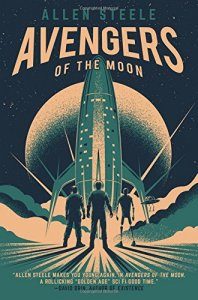Paul Di Filippo Reviews Weird Tales: 100 Years of Weird edited by Jonathan Maberry
 Weird Tales: 100 Years of Weird, edited by Jonathan Maberry (Blackstone 979-8200687992, hardcover, 200pp, $27.99) October 2023
Weird Tales: 100 Years of Weird, edited by Jonathan Maberry (Blackstone 979-8200687992, hardcover, 200pp, $27.99) October 2023
I have yet to read any individual issue of the revived Weird Tales magazine, piloted by editor Jonathan Maberry. But I already know that this new periodical incarnation must be a class act, fully worthy of bearing forward into the future the celebrated name and lineage. My appraisal comes from enjoying this new hundredth anniversary volume so much, an undertaking that shows love, fine critical judgment, enthusiasm, esthetic appeal, and literary chops. The reborn magazine that inspired such a celebration must possess the same sterling qualities.
The first thing to mention before perusing the contents is the physical presentation. From its beautiful and even witty dustjacket illustration (all credit to Francesco Francavilla) to the embossed boards beneath; from the lavish endpapers through the many interior illustrations; from the judiciously deployed multi-colored type through the heavier-than-average paper stock—this whole package speaks of a generous design approach. All kudos to Blackstone Publishing for investing extra money and care.
As for the contents, they fall into four categories, nicely interleaved: classic reprints; new fiction; essays; and poems. So let’s check out each division.
Any attempt to celebrate the heritage of WT must rely on showing us some choice examples from the glory days. I count ten selections here (not counting a reprint essay). This number is almost precisely matched by the new, heretofore-unseen fiction and poems. Some might argue that the ratio is skewed, especially in a volume whose subtitle focuses on the lineage that was, not the days to come. But be that as it may, one can’t argue with the quality of the old stuff.
We get “The Call of Cthulhu” from Lovecraft, and “Worms of the Earth” by Howard. Both of these quintessential picks reveal their enduring charms quite well. But some of the less-prominent choices almost outshine them. Bradbury’s “The Scythe” is a grim and implacable account of a fellow who steps into some impossible mortality-inducing shoes. “Legal Rites” by Asimov and Pohl conflates ghosts and jurisprudence delightfully. And “Slaughter House” by Matheson pulls out all the stops concerning an Old Dark Manse which two doomed brothers attempt to inhabit.
Although the title “The Vengeance of Nitocris” and its famous author, the sixteen-year-old Tennessee Williams, were well-known to me, I do not believe I had ever actually read the tale till now. It’s a delightfully florid and garishly envisioned story of death and revenge in the Classical world. I can just envision Williams writing it at his desk with a few drawings by Aubrey Beardsley hanging over him for inspiration.
But to my taste, the standout reprint is “The Damp Man”, by Allison V. Harding. A mix of cinematic suspense and Lovecraftian eldritchness, it could have been filmed by Jacques Tourneur. An exceptional realism about the psychology and reactions of the female lead point toward the gender contributions made by the pioneering Harding. All in all, a great choice by Maberry.
The new fiction is nicely and sturdily representative of twenty-first-century fantastika, although I don’t believe any of these tales, decades from now, will be recalled as fondly as those by Lovecraft, Howard, et al. R. L Stine’s “Disappear Donna”, wherein naïve teens run afoul of a malign countryside entity features some truly spooky moments. James Aquilone’s “Dead Jack and the Case of the Bloody Fairy” is primo urban fantasy, opening with this gem: “’A fairy doesn’t just explode and spew gallons of blood all over her apartment for no reason,’ Bernice Sunflower said, her eyes as red as the Pandemonium sky and as wet as the Broken Sea—whose waves angrily crashed against the dock.” And Keith R. A. DeCandido’s “Prezzo” evokes a tangible historical setting (urban immigrants in the early twentieth century) and an engaging juvenile protagonist, and then layers on spells and monsters to good effect.
The non-fiction offerings vary in their scholarship. Some tread ground that will be over-familiar to the diehard fan and connoisseur. But to those just dipping their toes into WT’s legacy, such essays will provide a useful introduction to the history. After all, every book is someone’s first encounter with the subject. Others, such as “NecronomiCommedia: Dante, Doré, and the Root of Lovecraftian Horror”, by Jacopo della Quercia and Christopher Neumann, advance existing scholarship by leaps and bounds.
Finally, all the poets contributing here can be proud of delivering the frisson-making goods. Michael A. Arnzen’s “The Church at the Bottom of the Sea” evokes watery hauntings, while Linda D. Addison’s “How to Make the Animal Perfect?” surprises us by being core science fiction in a Doctor Moreau vein. And Owl Goingback’s “Blood Moon” is lyrically gruesome.
Maberry commences his introduction by saying, “It’s a daunting thing to helm a magazine that has been around for a century…one that has had some truly luminous editors, among them Farnsworth Wright, Lin Carter, Forrest J Ackerman, Ann VanderMeer and so many others.” But he can hold his head up high as he steps into their august company.
 While you are here, please take a moment to support Locus with a one-time or recurring donation. We rely on reader donations to keep the magazine and site going, and would like to keep the site paywall free, but WE NEED YOUR FINANCIAL SUPPORT to continue quality coverage of the science fiction and fantasy field.
While you are here, please take a moment to support Locus with a one-time or recurring donation. We rely on reader donations to keep the magazine and site going, and would like to keep the site paywall free, but WE NEED YOUR FINANCIAL SUPPORT to continue quality coverage of the science fiction and fantasy field.
©Locus Magazine. Copyrighted material may not be republished without permission of LSFF.






